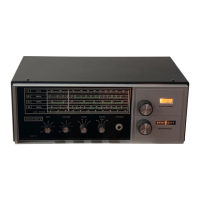T:
OPERATION
Before
attempting to use
the Receiver,
carefully read the
explanation
of each control. Figure
4
(fold-out
from Page
52) illustrates
the
front
panel
and describes
the
control
functions. Figure
5
illustrates
the rear
panel.
CONTROLS
VOLUME
-
Turns the Receiver
on or off
and controls the
sound
from the
speaker or
headphones.
BFO
-
Required for the reception
of
CW or
SSB
(single
sideband) signals.
Turn
the control clockwise until
the
signals are received
as desired.
MODE
-
Selects
AM,
STBY. or CW
(including
SSB) modes
of
reception. In the
AM
position
the AVC voltage
ison; in the
CW
position
the AVC voltage
is off.
In the
STBY
position
the Receiver
is kept warmed up
and
ready
for instant
use
but it is keot muted.
BAND
-
Selects
one of
four
bands:
A, B, C, or D.
-IEA.TIII<IT'B'
MAIN TUNING
-
Tunes the Receiver
to the desired station.
BANDSPREAD
-
Provides fine
tuning for the MAIN
TUNIIJG
capacitor
to help separate the incoming
signals
from
each other
when they are near the same
frequency.
This
capacitor is
normally left in the
"0"
position
as its
position
affects
the main
dial
calibration.
AM OPERATION
The BFO
control
should
be in the
fully
counterclockwise
position.
Turn
the MODE
switch
to
AM and advance the
VOLUME control for
sufficient
volume.
Set
the BAND
switch to the desired
band
and tune in a station with the
MAIN TUNING
control.
Turn the BANDSPREAD
control until the
desired station
is
clearest.
When listening
to
weak
stations, slowly adjust
the
BFO
control
for
the
loudest
and clearest
reception.
CW-SSB
OPERATION
Turn the
BFO control 3/4 turn clockwise.
Turn the
MODE
switch to CW and set the
BAND switch to one
of the
shortwave bands, B, C, or D,
With the MAI N TUNING control,
tune in a CW station.
Adjust
the
BFO control as
follornrs:
Turn
the
control
fully
clockwise and
then slowly
counterclockwise
until
the
clearest
tone is
produced.
The frequency of this
tone
may be
varied
either with the
MAIN TUN
ING
or
the
BANDSPREAD
capacitor. Some
experimentation
will
be
necessarv
to
find
the best
position
for
the
BFO control.
53

